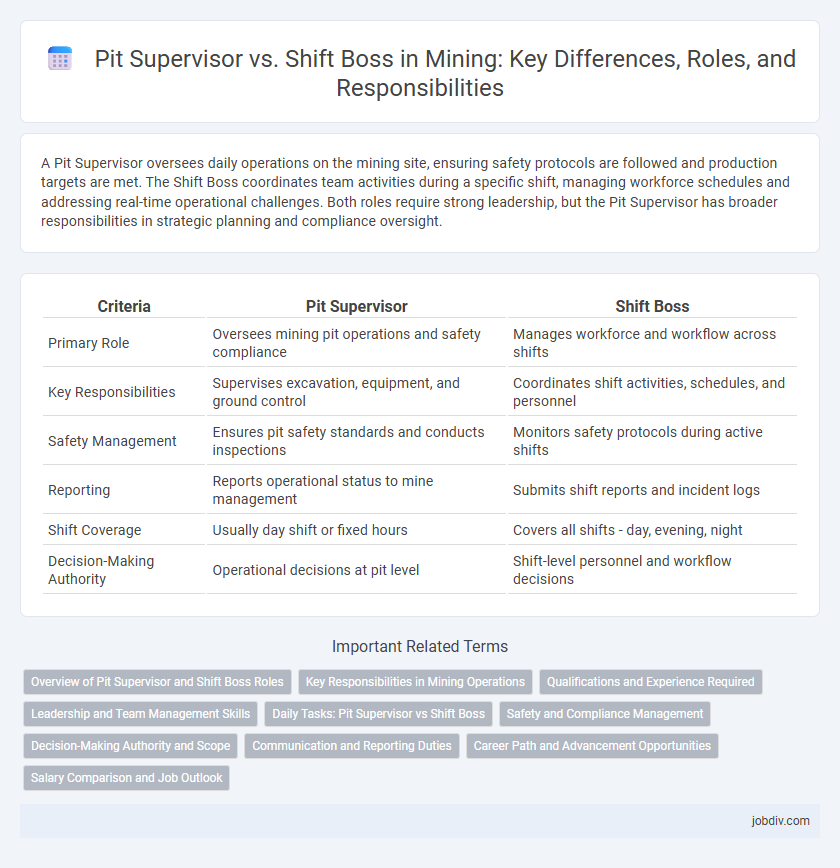A Pit Supervisor oversees daily operations on the mining site, ensuring safety protocols are followed and production targets are met. The Shift Boss coordinates team activities during a specific shift, managing workforce schedules and addressing real-time operational challenges. Both roles require strong leadership, but the Pit Supervisor has broader responsibilities in strategic planning and compliance oversight.
Table of Comparison
| Criteria | Pit Supervisor | Shift Boss |
|---|---|---|
| Primary Role | Oversees mining pit operations and safety compliance | Manages workforce and workflow across shifts |
| Key Responsibilities | Supervises excavation, equipment, and ground control | Coordinates shift activities, schedules, and personnel |
| Safety Management | Ensures pit safety standards and conducts inspections | Monitors safety protocols during active shifts |
| Reporting | Reports operational status to mine management | Submits shift reports and incident logs |
| Shift Coverage | Usually day shift or fixed hours | Covers all shifts - day, evening, night |
| Decision-Making Authority | Operational decisions at pit level | Shift-level personnel and workflow decisions |
Overview of Pit Supervisor and Shift Boss Roles
Pit Supervisors oversee daily mining operations, ensuring safety protocols, equipment functionality, and productivity standards are met within the open pit environment. Shift Bosses manage crew activities during specific shifts, coordinating tasks, maintaining communication between teams, and addressing immediate operational issues. Both roles require strong leadership and detailed knowledge of mining processes but differ in scope, with Pit Supervisors holding broader responsibility over the entire pit operation.
Key Responsibilities in Mining Operations
Pit Supervisors oversee daily mining activities, ensuring compliance with safety regulations, managing equipment operations, and coordinating workforce tasks to optimize ore extraction. Shift Bosses focus on supervising workers during their shifts, maintaining productivity levels, monitoring safety protocols, and reporting operational issues to higher management. Both roles are critical for maintaining efficient mining operations, with the Pit Supervisor having broader operational oversight compared to the Shift Boss's shift-specific leadership.
Qualifications and Experience Required
A Pit Supervisor typically requires a diploma or degree in mining engineering or a related field, with 5-7 years of underground or surface mining experience, including expertise in safety regulations, equipment operation, and team leadership. In contrast, a Shift Boss often holds a technical certification or diploma with 3-5 years of hands-on experience managing daily operations, coordinating shift personnel, and ensuring production targets are met safely. Both roles demand strong knowledge of mining processes and regulatory compliance, but the Pit Supervisor usually has broader responsibilities in planning and technical oversight.
Leadership and Team Management Skills
Pit Supervisors excel in operational leadership by coordinating mining activities, ensuring safety protocols, and optimizing resource extraction, while Shift Bosses focus on managing shift-level team performance and maintaining continuous workflow. Both roles require strong communication, problem-solving skills, and the ability to motivate diverse teams under high-pressure conditions in mining environments. Effective leadership in pit supervision involves strategic decision-making and compliance oversight, whereas shift bosses emphasize direct team supervision and immediate issue resolution.
Daily Tasks: Pit Supervisor vs Shift Boss
Pit Supervisors oversee excavation activities, ensuring adherence to safety protocols and operational efficiency while managing equipment and workforce allocation on-site. Shift Bosses coordinate daily labor assignments, monitor production targets, and handle immediate issue resolution to maintain uninterrupted mining operations during each shift. Both roles require vigilance in compliance, real-time decision-making, and communication with management to optimize mine productivity.
Safety and Compliance Management
Pit Supervisors hold primary responsibility for enforcing safety protocols and regulatory compliance within mining operations, ensuring all team members adhere to established standards to prevent accidents. Shift Bosses manage on-site activities during their shifts, focusing on real-time hazard identification and quick response to safety incidents to maintain a secure working environment. Both roles collaborate closely to uphold mining safety regulations, but the Pit Supervisor emphasizes strategic compliance management while the Shift Boss prioritizes operational safety enforcement.
Decision-Making Authority and Scope
Pit Supervisors hold extensive decision-making authority focused on operational safety, equipment maintenance, and task allocation within defined pit sections, directly influencing daily production efficiency. Shift Bosses exercise broader scope overseeing multiple teams during shifts, making critical real-time decisions on workforce coordination, emergency response, and compliance with safety regulations across the entire mining site. The distinction lies in Pit Supervisors' specialized control over specific mining operations versus Shift Bosses' strategic oversight of shift-wide activities and resource management.
Communication and Reporting Duties
Pit Supervisors manage daily mining operations, ensuring safety protocols and operational efficiency are followed, while Shift Bosses oversee workforce coordination and task assignments during shifts. Effective communication for Pit Supervisors involves detailed reporting on equipment status, production metrics, and safety incidents to upper management. Shift Bosses focus on real-time communication with crew members to address immediate operational issues and provide shift activity reports to supervisors.
Career Path and Advancement Opportunities
Pit Supervisors oversee daily mining operations, ensuring safety and efficiency, often requiring substantial field experience and technical expertise. Shift Bosses manage workforce coordination and operational flow during specific shifts, serving as a critical link between workers and management, with opportunities for progression into supervisory or managerial roles. Career advancement typically sees Shift Bosses moving up to Pit Supervisor positions, while Pit Supervisors may advance into higher-level mine management or specialized technical roles.
Salary Comparison and Job Outlook
Pit Supervisors typically earn between $65,000 and $85,000 annually, reflecting their responsibility for managing specific excavation operations and ensuring safety compliance. Shift Bosses, overseeing entire shifts and coordinating multiple teams, often command higher salaries ranging from $75,000 to $95,000 due to broader operational duties and leadership roles. Job outlook for both positions remains strong, driven by increasing demand for efficient mining operations and advancements in safety regulations, with Shift Boss roles expected to experience slightly higher growth due to expanded management responsibilities.
Pit Supervisor vs Shift Boss Infographic

 jobdiv.com
jobdiv.com